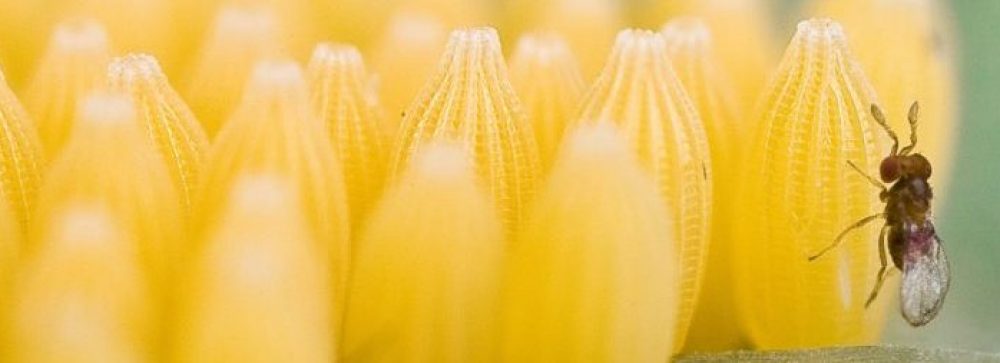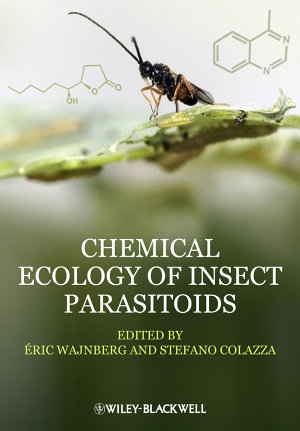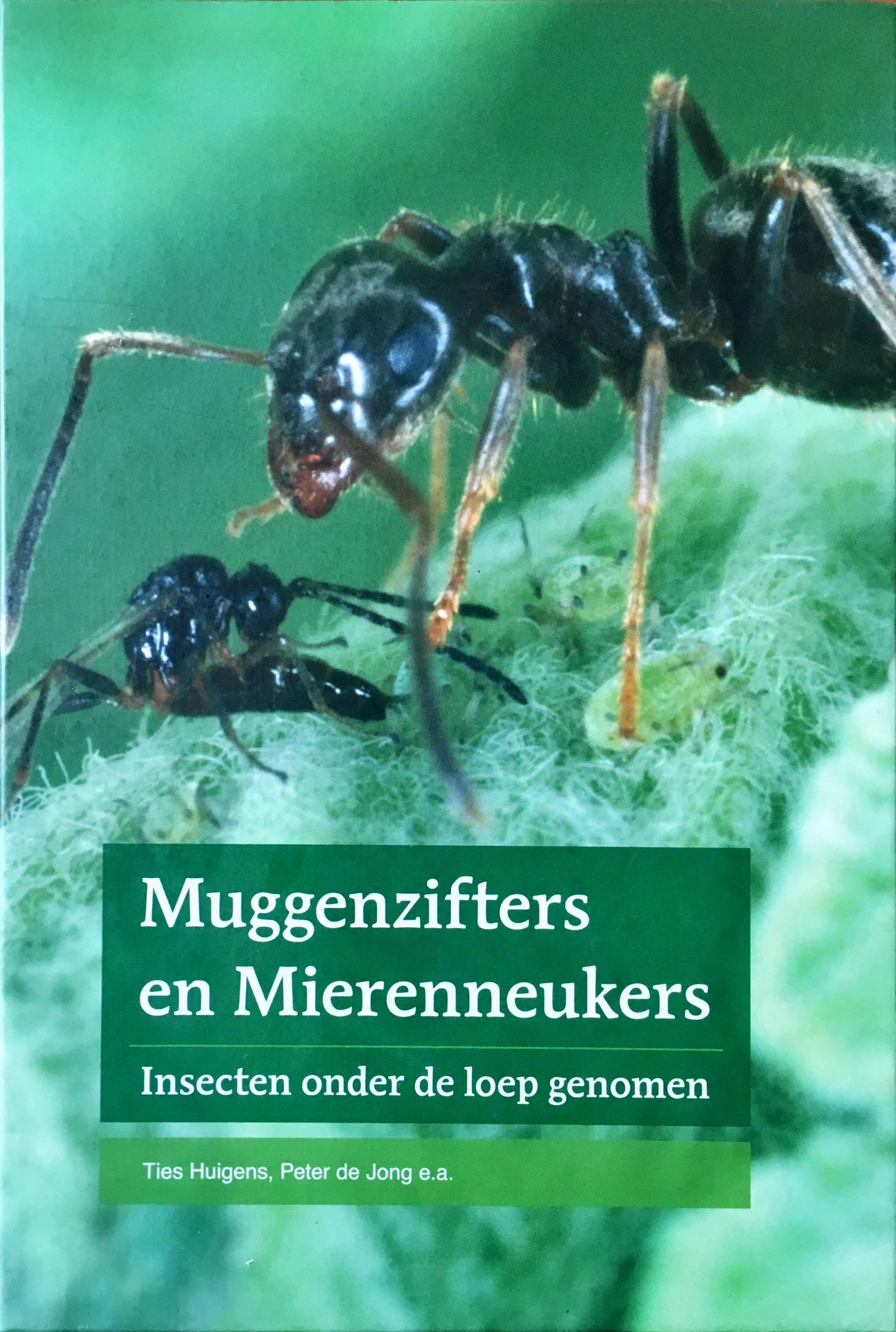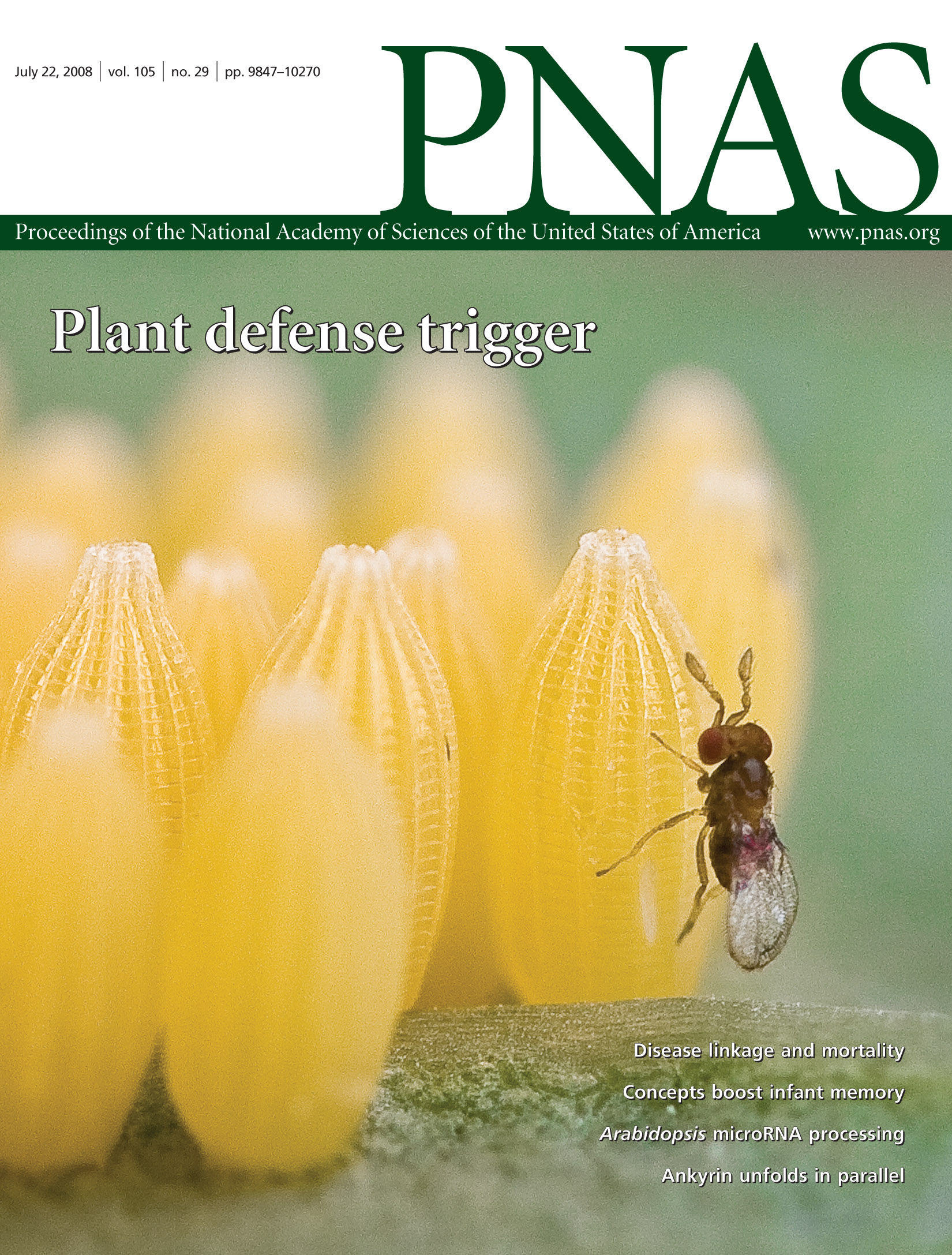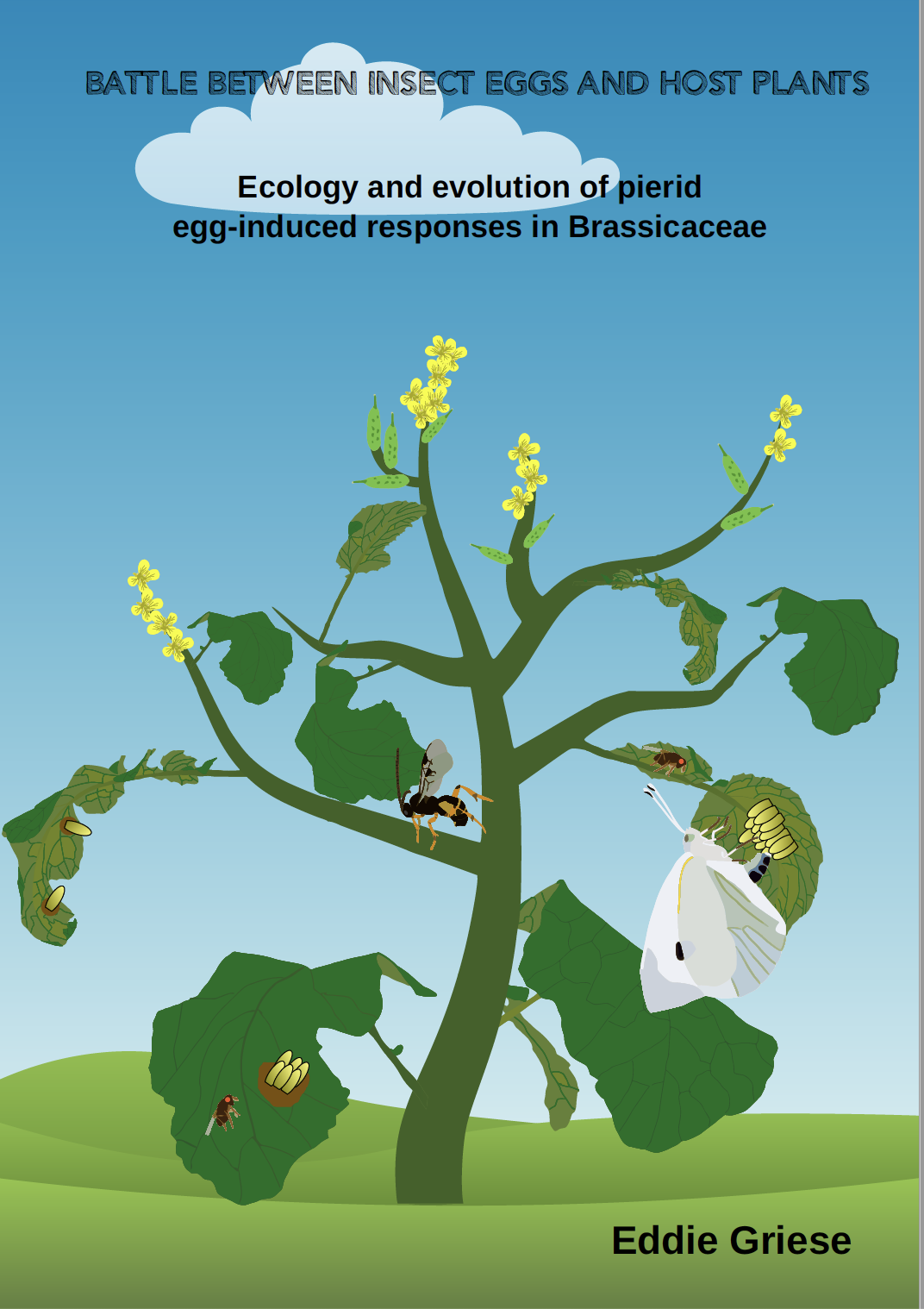2024
Peters, D. H., Greenberg, L. O., & Fatouros, N. E. (2024). Oviposition strategies in Pieridae butterflies and the role of an egg-killing plant trait therein. Ecology and Evolution, 14, e11697. OPEN ACCESS
Mazzoni V., Anfora G., Cocroft R.B., Fatouros N.E., Groot A.T., Gross J., Hill P.S.M., Hoch H., Ioriatti C., Nieri R., Pekas A., Stacconi M.V.R., Stelinski L.L., Takanashi T., Virant-Doberlet M. & Wessel A. (2024) Bridging biotremology and chemical ecology: a new terminology. Trends in Plant Science, 8, 848-855 OPEN ACCESS with journal cover
Bassetti, N., Caarls, L., Bouwmeester, K., Verbaarschot, P., Eijden, E., Zwaan, B. J., Bonnema, G., Schranz, M.E. & Fatouros, N.E. (2024) A butterfly egg-killing hypersensitive response in Brassica nigra is controlled by a single locus, PEK, containing a cluster of TIR-NBS-LRR receptor genes. Plant, Cell & Environment, 47, 1009–1022. OPEN ACCESS
2023
van Lenteren, J. C., Bueno, V. H. P., Santos-Silva, M., Montes, F. C., Cusumano, A., & Fatouros, N. E. (2023). The Neotropical mirid predator Macrolophus basicornis uses volatile cues to avoid contacting old, Trichogramma pretiosum parasitized eggs of Tuta absoluta. Bulletin of Insectology, 76(2), 229-237.
Bueno, V. H. P., Cusumano, A., Santos-Silva, M., Montes, F. C., Parra, J. R. P., Fatouros, N. E., & van Lenteren, J. C. (2023). Intensity of intraguild predation of parasitized eggs by mirid predators depends on time since parasitization: a case study with the parasitoid Trichogramma pretiosum and the predator Macrolophus basicornis attacking Tuta absoluta eggs. Bulletin of Insectology, 76(2), 209-218.
Bogka, G., Anastasaki, E., Milonas, P. G., Psoma, A., Kabourakis, E. M., Zwaan, B. J., . . . Fatouros, N. E. (2023). Chemical cues involved in the host foraging behavior of Psyttalia concolor wasps to locate the olive fruit fly Bactrocera oleae. Frontiers in Ecology and Evolution, 11. OPEN ACCESS
Greenberg, L.O., Cusumano, A., Groot, A.T., Huigens, M.E. & Fatouros, N.E. (2023) The dynamic nature of host finding by egg parasitoids of herbivores: a co-evolutionary perspective. Current Opinion in Insect Sciences 55: 101002. OPEN ACCESS
Caarls, L., Bassetti, N., Verbaarschot, P., Mumm, R., van Loon, J.J.A., Schranz, M.E. & Fatouros, N.E. (2023) Hypersensitive-like response induced by cabbage white butterflies is specifically induced by molecules from egg-associated secretions in Brassica plants. Frontiers Ecology and Evolution 10: 1070859. OPEN ACCESS
Hilker, M., Salem, H. & Fatouros, N.E. (2023) Adaptive Plasticity of Insect Eggs. Annual Review of Entomology 68: 451-469. OPEN ACCESS
2022
Bassetti, N., Caarls, L., Bukovinszkine’Kiss, G., El-Soda, M., van Veen, J., Bouwmeester, K., Zwaan, B.J., Schranz, M.E., Bonnema, G., Fatouros, N.E. (2022) Genetic analysis reveals three novel QTLs underpinning a butterfly egg-induced hypersensitive response-like cell death in Brassica rapa. BMC Plant Biology 22: 140. OPEN ACCESS Suppl. material
Corné F.H. van der Linden, Fatouros, N.E. and Kammenga, J.E. (2022). The potential of entomopathogenic nematodes to control moth pests of ornamental plantings. Biological Control 165, OPEN ACCESS
2021
Afentoulis, D.G., Cusumano, A., Greenberg, L.O., Caarls, L. and Fatouros, N.E. (2021). Attraction of Trichogramma Wasps to Butterfly Oviposition-Induced Plant Volatiles Depends on Brassica Species, Wasp Strain and Leaf Necrosis. Frontiers in Ecology and Evolution 9, 703134 OPEN ACCESS Suppl. material
Griese*, E., Caarls*, L., Bassetti, N., Mohammadin, S., Verbaarschot, P., Bukovinszkine’Kiss, G., Poelman, E.H., Gols, R., Schranz, M.E. & Fatouros, N.E. (2021) Insect egg-killing: a new front on the evolutionary arms-race between Brassicaceae plants and Pierid butterflies. New Phytologist 230: 341-353 OPEN ACCESS Suppl. info.
2020
Valsamakis, G., Bittner, N., Fatouros, N.E., Kunze, R., Hilker, M. and Lortzing, V. (2020). Priming by Timing: Arabidopsis thaliana adjusts its priming response to Lepidoptera eggs to the time of larval hatching. Frontiers in Plant Science 11:1969. OPEN ACCESS Suppl. info
Fatouros, N.E., Cusumano, A., Bin, F., Polaszek, A., and van Lenteren, J.C. (2020). How to escape from insect egg parasitoids: a review of potential factors explaining parasitoid absence across the Insecta. Proceedings of the Royal Society B: Biological Sciences 287:20200344. DOI. Suppl. info. With journal cover.
Leung, K., Ras, E., Ferguson, K.B., Ariëns, S., Babendreier, D., Bijma, P., Bourtzis, K., Brodeur, J., Bruins, M.A., Centurión, A., Chattington, S.R., Chinchilla‐Ramírez, M., Dicke, M., Fatouros, N.E., González‐Cabrera, J., Groot, T.V.M., Haye, T., Knapp, M., Koskinioti, P., Le Hesran, S., Lyrakis, M., Paspati, A., Pérez‐Hedo, M., Plouvier, W.N., Schlötterer, C., Stahl, J.M., Thiel, A., Urbaneja, A., van de Zande, L., Verhulst, E.C., Vet, L.E.M., Visser, S., Werren, J.H., Xia, S., Zwaan, B.J., Magalhães, S., Beukeboom, L.W. and Pannebakker, B.A. (2020). Next‐generation biological control: the need for integrating genetics and genomics. Biological Reviews 95: 1838-1854. DOI.
Pashalidou, F.G., Eyman, L., Sims, J., Buckley, J., Fatouros, N.E., De Moraes, C.M. & Mescher, M.C. (2020) Plant volatiles induced by herbivore eggs prime defences and mediate shifts in the reproductive strategy of receiving plants. Ecology Letters 23, 1097–1106. DOI.
Paniagua Voirol, L.R., Valsamakis, G., Lortzing, V., Weinhold, A., Johnston, P.R., Fatouros, N.E., Kunze, R. & Hilker, M. (2020) Plant responses to insect eggs are not induced by egg-associated microbes, but by a secretion attached to the eggs. Plant, Cell & Environment 43, 1815-1826. DOI. With commentary and journal cover.
Paniagua Voirol, L.R., Weinhold, A., Johnston, P.R., Fatouros, N.E. & Hilker, M. (2020) Legacy of a Butterfly’s Parental Microbiome in Offspring Performance. Applied and Environmental Microbiology 86, e00596-00520. DOI
Frago, E., Zytynska, S.E. & Fatouros, N.E. (2020) Chapter Four – Microbial symbionts of herbivorous species across the insect tree. In Advances in Insect Physiology (eds. K.M. Oliver & J.A. Russell), pp. 111-159, Academic Press. PDF
Griese, E., Pineda, A., Pashalidou, F.G., Pizarro Iradi, E., Hilker, M., Dicke, M. and Fatouros, N.E. (2020). Plant responses to butterfly oviposition partly explain preference–performance relationships on different brassicaceous species. Oecologia, 192:463–475. DOI
2019
Cascone, P., Gols, R., Fatouros, N.E., Ponzio, C., Dicke, M., Guerrieri, E. (2019). The effect of rearing history and aphid density on volatile-mediated foraging behaviour of Diaeretiella. Ecological Entomology, 44 (2), 255-264. DOI
JB Woelke, VN Fursov, AV Gumovsky, M de Rijk, C Estrada, P Verbaarschot, ME Huigens, NE Fatouros (2019). Description and biology of two new egg parasitoid species (Hymenoptera: Trichogrammatidae) reared from eggs of Heliconiini butterflies (Lepidoptera: Nymphalidae: Heliconiinae) in Panama. Journal of Natural History 53 (11-12), 639-657 DOI. Winner of Taylor & Francis EO Wilson Prize 2019.
2018
Zhu, F., Cusumano, A., Bloem, J., Weldegergis, B., Villela, A., Fatouros, N.E., van Loon, J.J.A., Dicke, M., Harvey, J., Vogel, H. and Poelman, E.H. (2018). Symbiotic polydnavirus and venom reveal parasitoid to its hyperparasitoids. Proceedings of the National Academy of Sciences of the USA, 115, 5205-5210. DOI
Paniagua Voirol, L.R., Frago, E., Kaltenpoth, M., Hilker, M. and Fatouros, N.E. (2018). Bacterial symbionts in Lepidoptera: Their diversity, transmission and impact on the host. Frontiers Microbiology, 9, 556. OPEN ACCESS
2017
Griese, E., Dicke, M., Hilker, M., and Fatouros, N.E. (2017) Plant response to butterfly eggs: inducibility, severity and success of egg-killing leaf necrosis depends on plant genotype and egg clustering. Scientific Reports, 7, 7316. OPEN ACCESS
2016
Fatouros, N.E., Cusumano, A., Danchin, E.G.J., and Colazza, S. (2016) Prospects of pest-killing defenses for sustainable crop protection. Ecology and Evolution, 6, 6906-6918. OPEN ACCESS
Hilker, M., and Fatouros, N.E. (2016). Resisting the onset of herbivore attack: plants perceive and respond to insect eggs. Current Opinion Plant Biology, 32, 9-16. DOI
Ponzio, C., Cascone, P., Cusumano, A., Weldegergis, B.T., Fatouros, N.E., Guerrieri, E., Dicke, M. & Gols, R. (2016) Volatile-mediated foraging behaviour of three parasitoid species under conditions of dual insect herbivore attack. Animal Behavior, 111, 197-206. DOI
2015
Pashalidou, F.G., Fatouros, N.E., van Loon, J.J.A., Dicke, M. & Gols, R. (2015c) Plant-mediated effects of butterfly egg deposition on subsequent caterpillar and pupal development, across different species of wild Brassicaceae. Ecological Entomology, 40, 444-450. DOI
Fatouros, N.E., Paniagua Voirol, L.R., Drizou, F., Doan, T.Q., Pineda, A., Frago, E. & van Loon, J.J.A. (2015) Role of Large Cabbage White butterfly male-derived compounds in elicitation of direct and indirect egg-killing defenses in the black mustard. Frontiers in Plant Science, 6, 794. OPEN ACCESS
Cusumano, A., Weldegergis, B., Colazza, S., Dicke, M. & Fatouros, N.E. (2015) Attraction of egg-killing parasitoids toward induced plant volatiles in a multi-herbivore context. Oecologia, 179, 163-174. DOI
Pashalidou, F.G., Frago, E., Griese, E., Poelman, E., van Loon, J.J.A., Dicke, M. & Fatouros, N.E. (2015b) Early herbivore alert matters: plant-mediated effects of egg deposition on higher trophic levels benefit plant fitness. Ecology Letters, 18, 927-936. DOI
Hilker, M. & Fatouros, N.E. (2015). Plant responses to insect egg deposition. Annual Review of Entomology, 60, 493-515. DOI
Pashalidou, F.G., Gols, R., Berkhout, B., Weldegergis, B., van Loon, J.J.A., Dicke, M. & Fatouros, N.E. (2015a). To be in time: egg deposition enhances plant-mediated detection of young caterpillars by parasitoids. Oecologia, 177, 477-486. DOI
2014
Fatouros, N. E., Pineda, A., Huigens, M. E., Broekgaarden, C., Shimwela, M. M., Figueroa Candia, I. A., Verbaarschot, P. & Bukovinszky, T. (2014). Synergistic effects of direct and indirect defences on herbivore egg survival in a wild crucifer. Proceedings of the Royal Society B: Biological Sciences, 281, 20141254. DOI, DRYAD DATA
2013
Pashalidou, F.G., Lucas-Barbosa, D., van Loon, J.J.A, Dicke, M. & Fatouros, N.E. (2013). Phenotypic plasticity of plant response to herbivore eggs: effects on resistance to caterpillars and plant development. Ecology, 94, 702-713. DOI
Huigens, M.E. & Fatouros, N.E. (2013). A hitchhiker’s guide to parasitism: Chemical ecology of phoretic insect parasitoids. In: Recent Advances in Chemical Ecology of Insect Parasitoids (Eds. E. Wajnberg, S. Colazza), pp. 86-111. BOOK
2012
Kruidhof, M.H., Pashalidou, F.G., Fatouros, N.E., Figueroa Candia, I.A., Vet, L.E.M., Smid, H.M. & Huigens, M.E. (2012). Reward value determines memory consolidation in parasitic wasps. PloSONE, 7, e39615. OPEN ACCESS
Fatouros, N.E., Lucas-Barbosa, D., Pashalidou, F.G., Weldegergis, B., Van Loon, J.J.A., Dicke, M., Gols, R., Harvey, J. & Huigens, M.E. (2012). Plant volatiles induced by herbivore egg deposition affect insects of different trophic levels. PloSONE 7, e43607. OPEN ACCESS
Blenn, B., Bandoly, M., Küffner, A. Otte, T., Geiselhardt, S., Fatouros, N.E. & Hilker, M. (2012). Insect egg deposition induces indirect defense and epicuticular wax changes in Arabidopsis thaliana. Journal of Chemical Ecology, 38, 882-892. DOI
Fatouros, N.E. & Huigens, M.E. (2012). Phoresy in the field: natural occurrence of Trichogramma egg parasitoids on butterflies and moths. BioControl 57,493–502. OPEN ACCESS
Van Loon, J.J.A., Dicke, M., Fatouros, N.E., Gols, R., de Jong, P., Poelman, E., Soler, R. (2012). 14th international symposium on insect-plant interactions. Preface. Entomologia Experimentalis et Applicata, 144, 1.
2010-2004
Huigens, M.E., Woelke, J.F., Pashalidou, F.G., Smid, H.M., Bukovinszky, T. & Fatouros, N.E. (2010). Chemical espionage on species-specific butterfly anti-aphrodisiac by hitch-hiking Trichogramma wasps. Behavioral Ecology, 21, 470-478.
Guerrieri, E., Huigens, M.E, Estrada, C., Woelke, J.F., De Rijk, M., Fatouros, N.E., Aiello, A. & Noyes, J.S. (2010). Ooencyrtus marcelloi sp. nov. (Hymenoptera: Encyrtidae), an egg parasitoid of Heliconiini (Lepidoptera: Nymphalidae: Heliconiinae) on passion vines (Malpighiales: Passifloraceae) in Central America. Journal of Natural History, 44, 81-87.
Pashalidou, F.G, Huigens, M.E., Dicke, M. & Fatouros, N.E. (2010). The use of oviposition-induced plant cues by Trichogramma wasps. Ecological Entomology, 35, 748-753.
Fatouros, N.E., Pashalidou, F.G., Aponte Cordero, W.V., van Loon, J.J.A., Mumm, R., Dicke, M., Hilker, M. &. Huigens, M.E. (2009). Anti-aphrodisiac compounds of male butterflies increase the risk of egg parasitoid attack by inducing plant synomone production. Journal of Chemical Ecology, 35, 1373-1381.
Huigens, M.E., Pashalidou, F.G., Qian, M., Bukovinszky, T., Smid, H.M., van Loon, J.J.A., Dicke, M. & Fatouros, N.E. (2009). Hitch-hiking parasitic wasp learns to exploit butterfly anti-aphrodisiac. Proceedings of the National Academy of Sciences of the USA, 106, 820-825. DOI
Fatouros, N.E., Broekgaarden, C., Bukovinszkine’Kiss, G., van Loon, J.J.A., Mumm, R., Huigens, M.E., Dicke, M. & Hilker, M. (2008). Male-derived butterfly anti-aphrodisiac mediates indirect plant defence. Proceedings of the National Academy of Sciences of the USA, 105, 10033-10038. With cover image and cover story. DOI, Commented in Nature Research Highlights. With journal cover.
Fatouros, N.E., Dicke, M., Mumm, R., Meiners, T. & Hilker, M. (2008). Foraging behavior of egg parasitoids exploiting chemical information. Behavioral Ecology, 19, 677-689.
Fatouros, N.E., Bukovinszkine’Kiss, G., Dicke, M., & Hilker, M (2007). The response specificity of Trichogramma egg parasitoids towards infochemicals during host location. Journal of Insect Behavior, 20, 53-65.
Gross, J., Fatouros, N.E., Hilker, M. (2007). The role of competitors on the evolution of the two allospecies of Chrysomela lapponica. Journal of Pest Science, 80, 139-143.
Fatouros N.E., Hilker M., Gross J. (2006). Reproductive isolation between populations from Northern and Central Europe of the leaf beetle Chrysomela lapponica L. Chemoecology, 16, 241-251.
Fatouros, N.E., Huigens, M.E., van Loon, J.J.A., Dicke, M., & Hilker, M. (2005a) Chemical communication – Butterfly anti-aphrodisiac lures parasitic wasps. Nature, 433, 704-704. DOI
Fatouros, N.E., Bukovinszkine’Kiss, G., Kalkers, L.A., Soler Gamborena, R., Dicke, M., & Hilker, M. (2005b). Oviposition-induced plant cues: do they arrest Trichogramma wasps during host location? Entomologia Experimentalis et Applicata, 115, 207-215.
Fatouros, N.E., Van Loon, J.J.A., Hordijk, K.A., Smid, H.M., & Dicke, M. (2005c). Herbivore-induced plant volatiles mediate in-flight host discrimination by parasitoids. Journal of Chemical Ecology, 31, 2033-2047.
Gross, J. & Fatouros, N.E. (2005). Striking differences in behaviour and ecology between populations of Chrysomela lapponica. Bonn Zoological Bulletin, 54, 247-252.
Gross, J., Fatouros, N.E., & Hilker, M. (2004a). The significance of bottom-up effects for host plant specialization in Chrysomela leaf beetles. Oikos, 105, 368-376.
Gross, J., Fatouros, N.E., Neuvonen, S., & Hilker, M. (2004b). The importance of specialist natural enemies for Chrysomela lapponica in pioneering a new host plant. Ecological Entomology, 29, 584-593.
Published book chapters
PhD theses
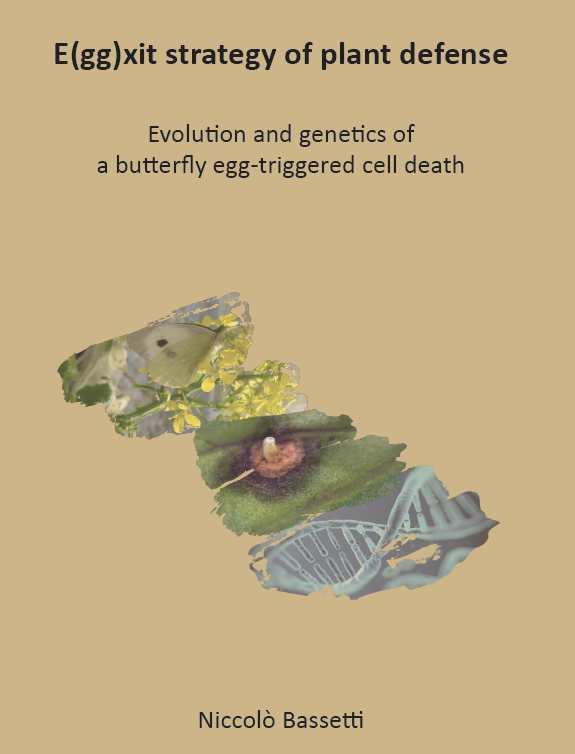
Niccolo Bassetti (2022). E(gg)xit strategy of plant defense. Evolution and genetics of a butterfly egg-triggered cell death. PhD thesis, Wageningen University.
Eddie Griese (2021). Battle between insect eggs and host plants: Ecology and evolution of pierid egg-induced responses in Brassicaceae. PhD thesis, Wageningen University.
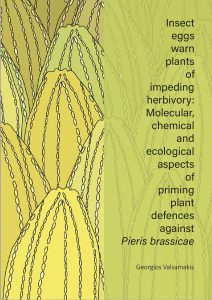 Georgios Valsamakis (2021). Insect eggs warn plants of impending herbivory: Molecular, chemical and ecological aspects of priming plant defences against Pieris brassicae. PhD thesis, Freie Universität Berlin.
Georgios Valsamakis (2021). Insect eggs warn plants of impending herbivory: Molecular, chemical and ecological aspects of priming plant defences against Pieris brassicae. PhD thesis, Freie Universität Berlin.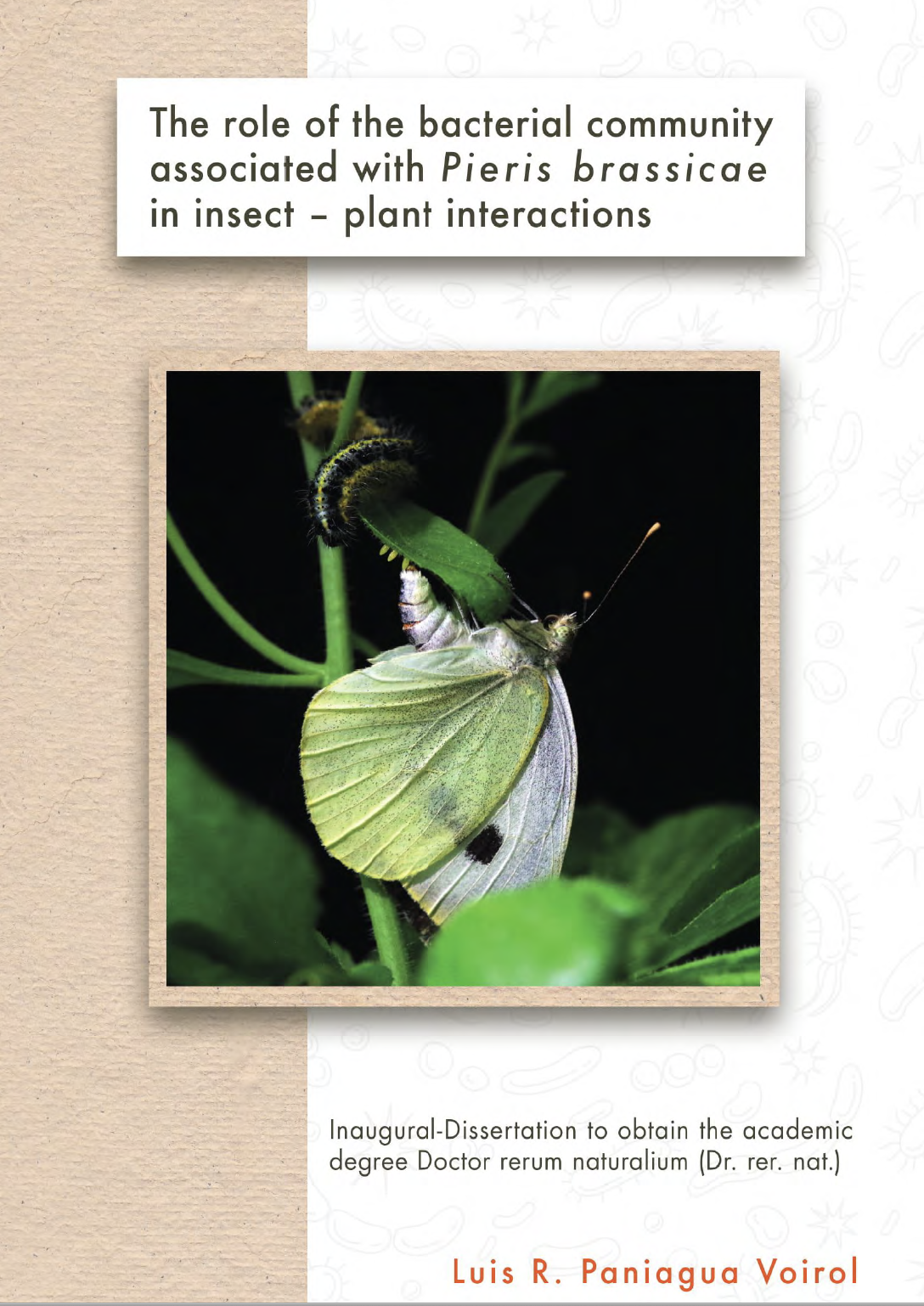 Luis R. Paniagua Voirol (2019). The role of the bacterial community associated with Pieris brassicae in insect – plant interactions. PhD thesis, Freie Universität Berlin.
Luis R. Paniagua Voirol (2019). The role of the bacterial community associated with Pieris brassicae in insect – plant interactions. PhD thesis, Freie Universität Berlin.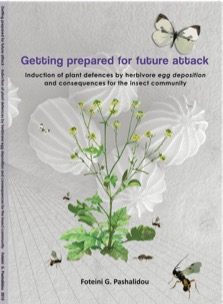 Foteini G. Pashalidou (2015). Getting prepared for future attack. Induction of plant defences by herbivore egg deposition and consequences for the insect community. PhD thesis, Wageningen University.
Foteini G. Pashalidou (2015). Getting prepared for future attack. Induction of plant defences by herbivore egg deposition and consequences for the insect community. PhD thesis, Wageningen University.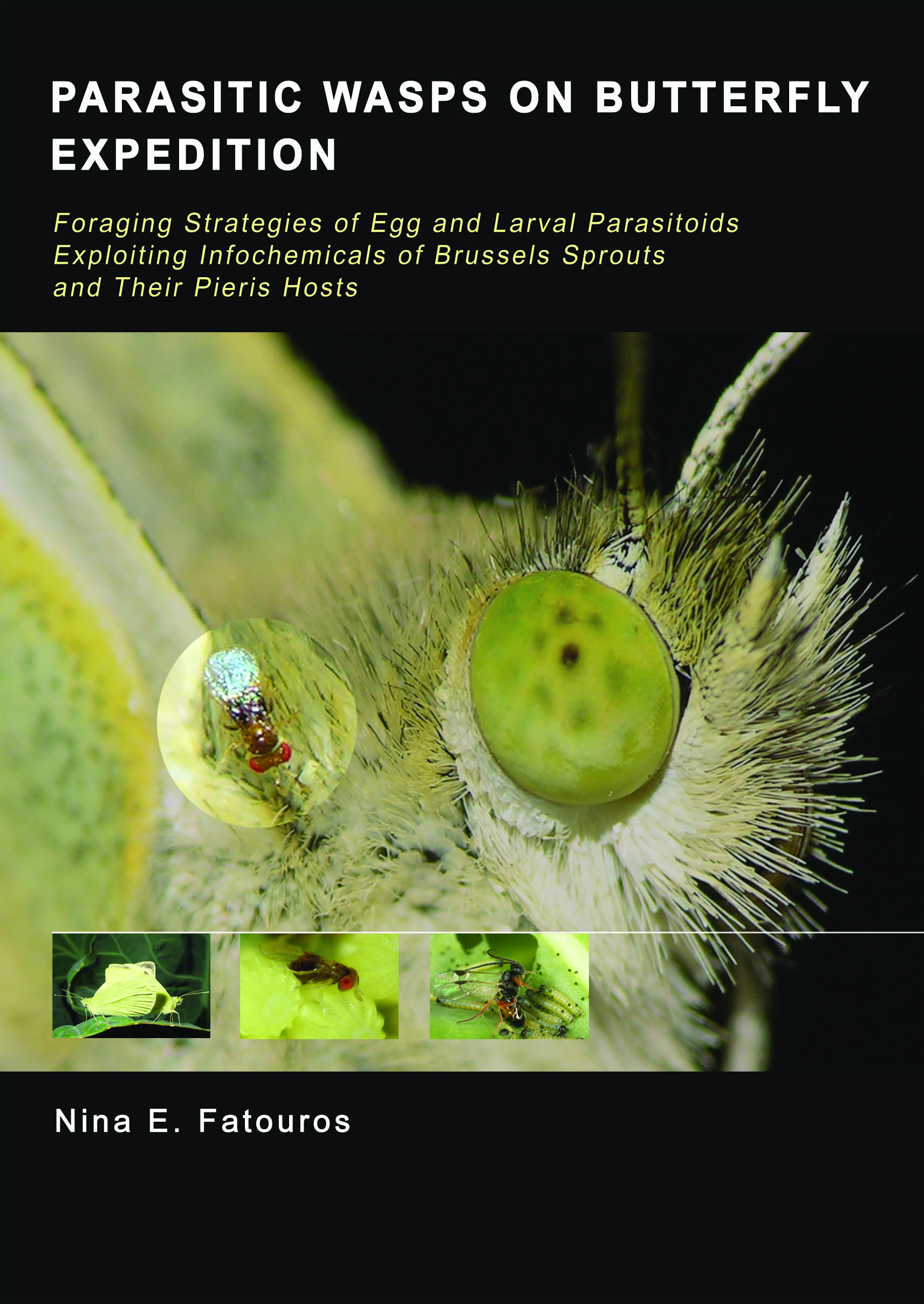 Nina E. Fatouros (2006). Parasitic wasps on butterfly expedition. Foraging strategies of egg and larval parasitoids exploiting infochemicals of Brussels sprouts ans their Pieris hosts. PhD thesis, Freie Universität Berlin.
Nina E. Fatouros (2006). Parasitic wasps on butterfly expedition. Foraging strategies of egg and larval parasitoids exploiting infochemicals of Brussels sprouts ans their Pieris hosts. PhD thesis, Freie Universität Berlin.
